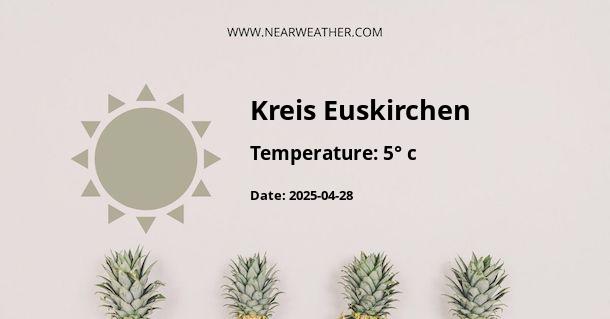Climate and Weather in Kreis Euskirchen, Germany
Kreis Euskirchen is a district in the south-west of North Rhine-Westphalia, Germany, known for its varied landscapes including the Eifel National Park, which contributes to the region’s distinct climate patterns. The district experiences a temperate oceanic climate with distinct seasons, influenced by its inland position and varied topography. Here we will delve into the climatic details and the weather characteristics that define Kreis Euskirchen throughout the year.
Seasonal Climates
The climate in Kreis Euskirchen has typical four-season characteristics, with moderately warm summers and cold winters, while spring and autumn offer transition periods that can range from crisp to rainy. The Eifel mountains tend to moderate the temperatures, especially in areas of higher elevation.
Spring
- Temperature: Average temperatures in spring range from 4 to 15 degrees Celsius. This season witnesses a gradual rise in temperatures with March being the coldest and May the warmest month in spring.
- Precipitation: Spring sees a fair amount of rainfall, with April traditionally being one of the wetter months of the year.
- Sunshine: The number of sunlight hours increases as the season progresses, leading to warmer days.
Summer
- Temperature: Average temperatures are around 18 to 24 degrees Celsius, but can reach above 30 degrees Celsius during heatwaves.
- Precipitation: Despite being a warm season, summer receives a significant amount of rainfall, often in the form of thunderstorms, due to the convection caused by the heat.
- Sunshine: The region enjoys the longest daylight hours of the year, with sunny weather interspersed with rainy days.
Fall
- Temperature: Temperatures decline steadily, ranging from 5 to 14 degrees Celsius. Late fall can see early frosts, especially in the more elevated areas.
- Precipitation: Like spring, fall is a transitional season and is characterized by wet weather, with October often being the rainiest month.
- Sunshine: Daylight hours reduce and cloud cover increases, leading to fewer hours of sunshine as winter approaches.
Winter
- Temperature: Average temperatures hover around 0 to 4 degrees Celsius, with cold snaps bringing sub-zero temperatures and frost, especially in the hilly regions.
- Precipitation: Snowfall is more likely in the elevated parts of the Eifel and occurs sporadically in the lower areas of Kreis Euskirchen.
- Sunshine: Winter days are short with limited sunshine, which can lead to a higher occurrence of foggy conditions.
Year-Round Weather Patterns
Although the district of Kreis Euskirchen has a generally moderate climate, it is also subject to extreme weather phenomena such as storms and heatwaves, particularly during the summer months. The variability in elevation across the district can cause microclimates, where weather conditions may differ noticeably from one locality to another.
Monthly Averages and Extremes
To give a more detailed breakdown of the climate in Kreis Euskirchen, below we will look at average temperature, precipitation, and record temperature extremes for each month of the year.
| Month | Average High (°C) | Average Low (°C) | Average Precipitation (mm) |
|---|---|---|---|
| January | 3 | -1 | 78 |
| February | 4 | -1 | 60 |
| March | 8 | 1 | 70 |
| April | 13 | 4 | 61 |
| May | 18 | 8 | 72 |
| June | 20 | 11 | 92 |
| July | 23 | 13 | 86 |
| August | 23 | 13 | 86 |
| September | 19 | 10 | 79 |
| October | 14 | 6 | 77 |
| November | 7 | 3 | 87 |
| December | 4 | 0 | 84 |
The recorded historical extremes in Kreis Euskirchen demonstrate the variability of the climate, with summer highs reaching up to the mid-30s (°C) during heatwaves, while winter lows can plunge below -10°C during cold spells.
Climate Influences and Factors
The climate of Kreis Euskirchen is subject to a number of influences that shape its overall patterns:
- Latitude: Situated in western Europe, the district has a latitude that secures a temperate climate, without the extremes found further north or south.
- Altitude: Varying elevations, particularly the Eifel mountain range, can alter local climate conditions, with higher areas being cooler and experiencing more precipitation.
- Proximity to the Atlantic Ocean: The nearby Atlantic Ocean helps regulate the temperature, keeping winters milder and summers cooler than those found further inland in Europe.
- Wind Patterns: Prevailing westerly winds can bring moisture from the Atlantic, leading to frequent rainfall and overcast conditions.
Climate Adaptations and Considerations
Residents and visitors to Kreis Euskirchen must adapt to the changing seasons and occasionally unpredictable weather. Proper clothing, building insulation, and infrastructure are essential to cope with weather extremes. Moreover, the agricultural industry needs to consider the best crop types for the given climate and soil conditions, and tourism activities are often seasonally focused, with hiking and outdoor sports being more prominent in summer, while the winter may attract visitors to Christmas markets or the snowy hills of the Eifel for winter sports.
Future Climate Projections
Climate change is expected to impact Kreis Euskirchen, as it does globally. Predictions for the region suggest an increase in temperature, particularly in summer, along with a potential increase in extreme weather events, including storms and heatwaves. These changes may require adaptations in agriculture, urban planning, and emergency services to mitigate the risks associated with a changing climate.
Note: All data and statistics presented are accurate as of the knowledge cutoff date and may be subject to change with ongoing climatic shifts. It is always best to consult the latest reports and forecasts from meteorological services for current and future climate considerations.
A - Kreis Euskirchen's Latitude is 50.545830 & Longitude is 6.655280.
A - Weather in Kreis Euskirchen is 5° today.
A - Climate Conditions in Kreis Euskirchen shows clear sky today.
A - Humidity in Kreis Euskirchen is 91% today.
A - Wind speed in Kreis Euskirchen is 3.13 km/h, flowing at 292° wind direction. today.
